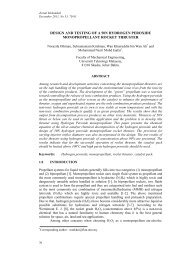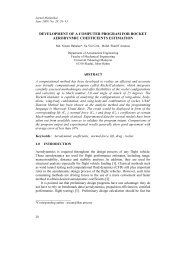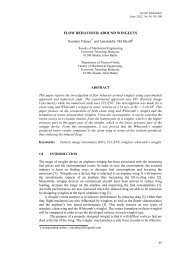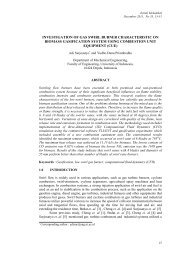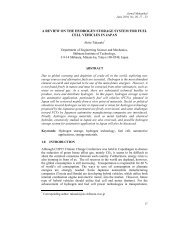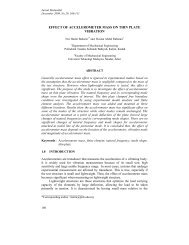structural performance analysis of formula sae car - Jurnal Mekanikal
structural performance analysis of formula sae car - Jurnal Mekanikal
structural performance analysis of formula sae car - Jurnal Mekanikal
You also want an ePaper? Increase the reach of your titles
YUMPU automatically turns print PDFs into web optimized ePapers that Google loves.
<strong>Jurnal</strong> <strong>Mekanikal</strong>, December 2010<br />
and knowledge, whole <strong>of</strong> the <strong>car</strong> was re-modeled and re-fabricated for international<br />
participation in USA as per the SAE rules. This time reduction <strong>of</strong> chassis weight<br />
minimally by 10% using new materials and efficient design was decided as one <strong>of</strong> the<br />
main objective <strong>of</strong> <strong>car</strong> development. New materials were deemed to use to widen the<br />
structure’s strength and re-modeled the design to inculcate more driver comfort, safety,<br />
structure triangulation and reduced inertial properties etc. The work started from the<br />
review <strong>of</strong> technical reports <strong>of</strong> several winning universities. Their main points regarding<br />
materials, design and load estimations were noted and discussed. Along with it,<br />
orthographic drawings, finite element <strong>analysis</strong> (FEA) reports <strong>of</strong> existing <strong>car</strong>’s chassis<br />
were also brainstormed and reasons <strong>of</strong> high stresses and displacements were tried to<br />
discover. Modes <strong>of</strong> load distribution and their deformation concepts were taken <strong>car</strong>e <strong>of</strong><br />
from various reference books. Some <strong>of</strong> the concepts are also enunciated in this paper to<br />
help other universities while preparing the design <strong>of</strong> their <strong>car</strong>.<br />
2.0 CHASSIS LOADING<br />
Frame is defined as a fabricated <strong>structural</strong> assembly that supports all functional vehicle<br />
systems. This assembly may be a single welded structure, multiple welded structures or a<br />
combination <strong>of</strong> composite and welded structures [1]. Depending upon application <strong>of</strong> loads<br />
and their direction, chassis is deformed in respective manner briefed as follows [2]:<br />
i. Longitudinal Torsion<br />
ii. Vertical Bending<br />
iii. Lateral Bending<br />
iv. Horizontal Lozenging<br />
2.1) Longitudinal Torsion<br />
Figure 1: Longitudinal Torsion [3]<br />
Application <strong>of</strong> equal and opposite forces act at a certain distance from an axis tends to<br />
rotate the body about the same axis. Automobiles also experience torsion while moving<br />
on road subjected to forces <strong>of</strong> different magnitudes acting on one or two oppositely<br />
opposed corners <strong>of</strong> the <strong>car</strong>s as shown in Figure 1. The frame can be thought as a torsion<br />
spring connecting the two ends where suspension loads act [2]. Torsional loading and<br />
resultant momentary elastic or permanent plastic deformation and subsequent unwanted<br />
deflections <strong>of</strong> suspension springs can affect the handling as well as <strong>performance</strong> <strong>of</strong> <strong>car</strong>.<br />
The resistance to torsional deformation is called as stiffness and it is expressed in<br />
Nm/degree in SI units. Torsional rigidity is a foremost and primary determinant <strong>of</strong> frame<br />
<strong>performance</strong> <strong>of</strong> <strong>car</strong>s.<br />
47



